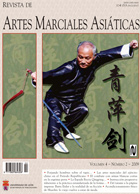Forjando homens sobre o tatami. As tradicionais “Artes Viris” e as Artes Marciais Asiáticas na América, por Geoffrey Wingard
DOI:
https://doi.org/10.18002/rama.v4i2.210Palavras-chave:
Artes marciais, desportos de combate, artes virisResumo
O presente artigo, “Forjando homens sobre o tatami”, apresenta as relações históricas entre a cultura popular americana e as artes de combate. O artigo utiliza documentos e outro material de arquivo entre os séculos XVIII e XX, recorrendo a análises sobre a literatura relevante no âmbito das ciências sociais. Procura-se demonstrar que as artes marciais são integrais na sociedade americana e que não são aquisições ad hoc da cultura popular contemporânea. De entre as várias artes de combate, discute-se especificamente a esgrima, a luta, o boxe e o judo.
Downloads
Métricas alternativas
Referências
BARTON-WRIGHT, E.W. (1902). Ju-jitsu and Ju-do. Transactions and proceedings of the Japan Society, London 5: 261-264.
BLACKWELL, E. (1734). A compleat system of fencing: Or, the art of defence. Williamsburg: William Parks.
Bowen, R. (1999). Origins of the British Judo Association, the European Judo Union & the International Judo Federation. Journal of Asian Martial Arts, 8(3): 43-53.
BURDICK, D. (1999). The American way of fighting: Unarmed defense in the United States, 1845-1945. Ph.D. Dissertation, University of Indiana.
BURNS, M. (1913). Jiu Jitsu–Self defense and their relation to wrestling: Lesson XII (Book VI). Omaha: Farmer Burns School of Wrestling.
CARR, K. (1993). Making way: War, philosophy and sport in Japanese judo. Journal of Sport History, 20(2): 167-188.
CASS, E. (1930). The book of fencing. Boston: Lothrop, Lee and Shepard, Co.
DONOVAN, M. (1909). The Roosevelt that I know: Ten years of boxing with the president – and other memories of famous men. New York: B.W. Dodge and Co.
DRAEGER, D. (1996). Modern bujutsu and budo: The martial arts and ways of Japan. New York: Weatherhill.
DRAEGER, D. & R. SMITH. (1980). Comprehensive Asian fighting arts. New York: Kodansha International.
DYKHUIZEN, J. (2000): Culture, training and perception of the martial arts: Aikido’s example. Journal of Asian Martial Arts, 9(3): 9-31.
FRIDAY, K. (1997). Legacies of the sword: The Kashima-Shinryu and samurai martial culture. Honolulu: University of Hawai’i Press.
FUNAKOSHI, G. (1975). Karate-do, my way of life. New York: Kodansha International.
GORN, E. (1985). Gouge and bite, pull hair and scratch: The social significance of fighting in the southern backcountry. American Historical Quarterly, 90(1): 18-43.
GRAY, W. RUSSELL. (1987). For whom the bell tolled: The decline of British prize fighting in the Victorian era. Journal of Popular Culture, 21(2): 53-64.
GUTTMANN, A. (1978). From ritual to record: The nature of modern sports. New York: Columbia University Press.
HOLLIMAN, J. (1975). American sports 1785-1835. No. 34 of Perspectives in American History. Philadelphia: Porcupine Press.
HOLT, R. (1989). Sport and the British: A modern history. Oxford: Clarendon Press.
HARDY, S. (1990). Entrepreneurs, structures and sportgeist. In Essays on Sport History and Sport Mythology, edited by Donald Kyle and Gary Stark. College Station: Texas A&M University Press.
JACKSON-LEARS, T. (1981). No place of grace: Anti-modernism and the transformation of American culture 1880-1920. New York: Pantheon Books.
JONES, H. (1943). Judo, jiu-jitsu, and hand-to-hand fighting: A list of references. Washington, D.C.: The Library of Congress Division of Bibliography.
LINDSAY, T. & J. KANO (1889). Jiujutsu the old samurai art of fighting without weapons, Transactions of the Asiatic Society of Japan, 16: 192-205.
LUSCHEN, G. (1981). The system of sport—Problems of methodology, conflict and social stratification. In Handbook of the Social Science of Sport, edited by Gunther Luschen and George Sage. Champaign, IL: Stipes Publishing Co.
MANDELL, R. (1984). Sport: A cultural history. New York: Columbia University Press.
MATSUDAIRA, T. (1910). Sports and physical training in modern Japan. Transactions and proceedings of the Japan Society, London, 8: 114-134.
MILLER, T., G. LAWRENCE, J. MCCAY & D. ROWE. (2001). Globalization and sport: Playing the world. London: Sage Publications.
NADI, A. (1943). On fencing. New York: G.P Putnam’s Son.
NITOBE, I. (1905). Bushido. New York: G.P. Putnam’s Sons.
NORMAN, F. (1905). The righting man of Japan, the training and exercises of the samurai. London: Archibald Constable & Co. Ltd.
PITTMAN, A. (1999). Combat wrestling: Geoghan’s blend from East and West. Journal of Asian Martial Arts, 8(4): 48-57.
SANSONE, D. (1988). Greek athletics and the genesis of sport. Berkeley: University of California Press.
SKIDMORE, M. (1995). Oriental contributions to Western popular culture: The martial arts. Journal of Popular Culture, 25(1): 129-148.
SMITH, R. (1996). The masters contest of 1926: An epiphany in judo history. Journal of Asian Martial Arts, 5(3): 60-65.
WINGARD, G. (2003). Sport, industrialism and the Japanese gentle way: Judo in late Victorian England. Journal of Asian Martial Arts, 12(2): 16-25.
WOLF, T. (2000). An introduction to the Journal of Manly Arts. Electronic Journals of Martial Arts and Sciences: Journal of Manly Arts, http://ejmas.com/jmanly/jmanlymission.htm (17 de febrero de 2003).
YUASA, Y. (1993). The body, self-cultivation, and ki energy. New York: State University of New York Press.
Downloads
Publicado
Como Citar
Edição
Secção
Licença
Direitos de Autor (c) 2012 Geoffrey Wingard

Este trabalho encontra-se publicado com a Licença Internacional Creative Commons Atribuição-NãoComercial-CompartilhaIgual 4.0.
Os autores que publicam nesta Revista estão de acordo com os seguintes termos:
- Os autores cedem, de forma exclusiva, os direitos de exploração (reprodução, distribuição, comunicação pública, transformação) à Universidade de Léon, podendo estabelecer, em separado, acordos adicionais para a distribuição não exclusiva da versão do artigo publicado na Revista (por exemplo: alojar no repertório institucional ou publicá-lo num livro), com o reconhecimento da publicação inicial nesta Revista.
- O trabalho encontra-se na Creative Commons Attribution-Non Commercial-Share Alike 4.0 International License. Pode-se consultar aqui o resumo e o texto legal da licença.
- Permite-se, e sugere-se, que os autores difundam electronicamente as versões pré-impressão (versão antes de ser avaliada) e pós-impressão (versão avaliada e aceite para publicação das suas obras antes da sua publicação), favorecendo a sua circulação e difusão, e com ela o possível aumento da sua citação e alcance pela comunidade académica.











